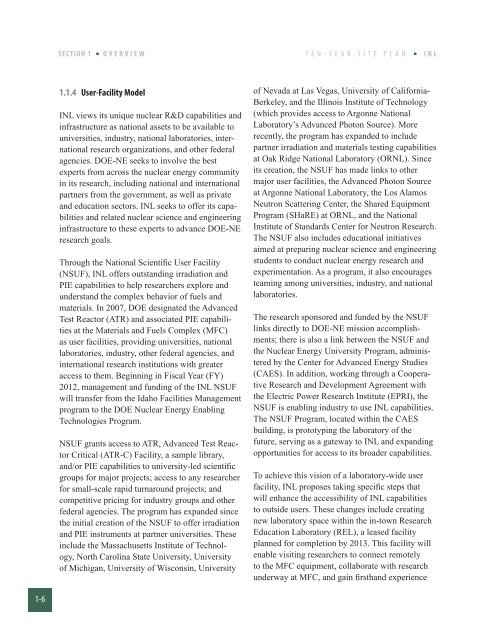2013-2022 TEN-YEAR SITE PLAN - Idaho National Laboratory
2013-2022 TEN-YEAR SITE PLAN - Idaho National Laboratory
2013-2022 TEN-YEAR SITE PLAN - Idaho National Laboratory
Create successful ePaper yourself
Turn your PDF publications into a flip-book with our unique Google optimized e-Paper software.
1-6<br />
SECTION 1 OVERVIEW<br />
1.1.4 User-Facility Model<br />
INL views its unique nuclear R&D capabilities and<br />
infrastructure as national assets to be available to<br />
universities, industry, national laboratories, international<br />
research organizations, and other federal<br />
agencies. DOE-NE seeks to involve the best<br />
experts from across the nuclear energy community<br />
in its research, including national and international<br />
partners from the government, as well as private<br />
and education sectors. INL seeks to offer its capabilities<br />
and related nuclear science and engineering<br />
infrastructure to these experts to advance DOE-NE<br />
research goals.<br />
Through the <strong>National</strong> Scientific User Facility<br />
(NSUF), INL offers outstanding irradiation and<br />
PIE capabilities to help researchers explore and<br />
understand the complex behavior of fuels and<br />
materials. In 2007, DOE designated the Advanced<br />
Test Reactor (ATR) and associated PIE capabilities<br />
at the Materials and Fuels Complex (MFC)<br />
as user facilities, providing universities, national<br />
laboratories, industry, other federal agencies, and<br />
international research institutions with greater<br />
access to them. Beginning in Fiscal Year (FY)<br />
2012, management and funding of the INL NSUF<br />
will transfer from the <strong>Idaho</strong> Facilities Management<br />
program to the DOE Nuclear Energy Enabling<br />
Technologies Program.<br />
NSUF grants access to ATR, Advanced Test Reactor<br />
Critical (ATR-C) Facility, a sample library,<br />
and/or PIE capabilities to university-led scientific<br />
groups for major projects; access to any researcher<br />
for small-scale rapid turnaround projects; and<br />
competitive pricing for industry groups and other<br />
federal agencies. The program has expanded since<br />
the initial creation of the NSUF to offer irradiation<br />
and PIE instruments at partner universities. These<br />
include the Massachusetts Institute of Technology,<br />
North Carolina State University, University<br />
of Michigan, University of Wisconsin, University<br />
T E N - Y E A R S I T E P L A N INL<br />
of Nevada at Las Vegas, University of California-<br />
Berkeley, and the Illinois Institute of Technology<br />
(which provides access to Argonne <strong>National</strong><br />
<strong>Laboratory</strong>’s Advanced Photon Source). More<br />
recently, the program has expanded to include<br />
partner irradiation and materials testing capabilities<br />
at Oak Ridge <strong>National</strong> <strong>Laboratory</strong> (ORNL). Since<br />
its creation, the NSUF has made links to other<br />
major user facilities, the Advanced Photon Source<br />
at Argonne <strong>National</strong> <strong>Laboratory</strong>, the Los Alamos<br />
Neutron Scattering Center, the Shared Equipment<br />
Program (SHaRE) at ORNL, and the <strong>National</strong><br />
Institute of Standards Center for Neutron Research.<br />
The NSUF also includes educational initiatives<br />
aimed at preparing nuclear science and engineering<br />
students to conduct nuclear energy research and<br />
experimentation. As a program, it also encourages<br />
teaming among universities, industry, and national<br />
laboratories.<br />
The research sponsored and funded by the NSUF<br />
links directly to DOE-NE mission accomplishments;<br />
there is also a link between the NSUF and<br />
the Nuclear Energy University Program, administered<br />
by the Center for Advanced Energy Studies<br />
(CAES). In addition, working through a Cooperative<br />
Research and Development Agreement with<br />
the Electric Power Research Institute (EPRI), the<br />
NSUF is enabling industry to use INL capabilities.<br />
The NSUF Program, located within the CAES<br />
building, is prototyping the laboratory of the<br />
future, serving as a gateway to INL and expanding<br />
opportunities for access to its broader capabilities.<br />
To achieve this vision of a laboratory-wide user<br />
facility, INL proposes taking specific steps that<br />
will enhance the accessibility of INL capabilities<br />
to outside users. These changes include creating<br />
new laboratory space within the in-town Research<br />
Education <strong>Laboratory</strong> (REL), a leased facility<br />
planned for completion by <strong>2013</strong>. This facility will<br />
enable visiting researchers to connect remotely<br />
to the MFC equipment, collaborate with research<br />
underway at MFC, and gain firsthand experience

















